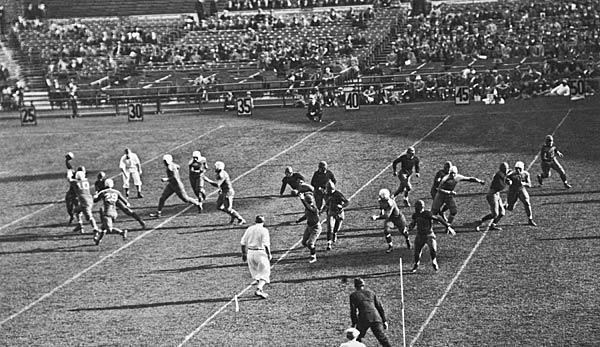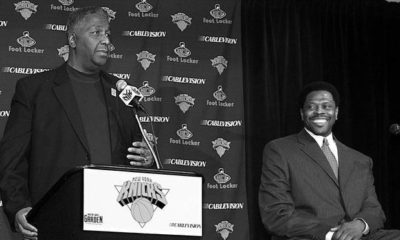US-Sport
Theme Week: Theme Week: Bloody Monday, Dead, 222:0 – how it all began
College Football has a long, rich history, full of crazy anecdotes, upheaval and development, full of social implications. This is also the cradle of football as we know it today. At the start of the College Football Theme Week, SPOX immerses itself in this story – and tells what the first steps of sport looked like.
There is an old saying that revenge is still best served cold. This can take years and sometimes even several sports.
This is what happened in Georgia in the 1910s.
John Heisman – after whom today’s trophy for the country’s best college player is named – coached both the Georgia Tech University baseball and football teams and one of the strangest anecdotes in well over 100 years of college football history is still told today as follows.
In the spring of 1915, Georgia Tech met the baseball team at Cumberland University, a small school just outside of Nashville. The underdog had bought several semi-professional players from Nashville – initially without it coming out – and promptly won the game 22-0, an incredible shock for Georgia Tech.
It was a defeat that made national headlines and made Heisman hard to deal with. Until he found out Cumberland had cheated.
Heisman swore revenge.
And he should get his revenge, even if he had to fight for it. First things first: A year after the baseball scandal, Cumberland faced financial problems and decided to put the football programme on hold and cancel the matches already scheduled. The opponents were informed accordingly – except, so the story goes, of all people, Georgia Tech.
A chance Heisman wouldn’t miss.
To make sure the game would take place, he wrote a letter to Cumberland offering $500 and all expenses for the trip to Atlanta. Just to postpone the fact that Georgia Tech would demand a compensation of 3000 dollars, Cumberland would have to cancel the game afterwards. A sum that could very well have ruined the small college.
So Cumberland’s coach – who kept the debacle secret from his director – were tied hands. A team of 13 to 19 players consisting of liaison students and also boys from the city was assembled. In order not to cause a stir with the university management, the training units were called choir meetings. The play-calls were completely simplified for the new football players, each player was assigned the name of a vegetable – as a code.
Of course, none of this helped, nor did the fact that three players had missed the connecting train to Georgia and were thus unavailable. In front of over 1000 fans, it was already 126-0 at half-time on October 7, 1916, when coach Heisman once again called his team to account for the second half and pointed out possible trick moves of the opponent.
The game that can serve as the epitome of the term “unequal duel” ended with 222:0. A duel between newcomers and one of the country’s top teams – Georgia Tech scored 33 consecutive wins at the time and won the National Championship in 1917.
Even if the Cumberland players of that time were supposed to protest: College football had already undergone a long development up to that 222-0, which made one of its origins – the “Bloody Monday” – forget. This tradition, not without reason, began at Harvard in 1827, originally as a wrestling match that gradually developed into a kind of football-football rugby mix.
The first semesters competed against the students in the second year, while the older students watched the spectacle and the scenery has to be imagined like this: On one side of the field the first-year students, on the other the slightly older students. All without helmets or pads, of course.
Suddenly a ball is thrown into the field and both teams attack each other. As soon as a chaotic crowd of people has formed, everything that moves or does not move is stepped on. If the ball happens to be there – all the better! This pile then moves across the field with the aim of somehow moving the leather over the opponent’s goal line.
This went on for over 30 years until the local police and college officials agreed: Bloody Monday had to go. The students protested, but it was in vain – there was no football at Harvard for more than twelve years.
But not until a group of young students in the finest dressing rooms literally buried football on September 3, 1860. In an extensive procession, a coffin was left in the ground under drums near the football field, an eulogy was spoken and a song was sung:
Ah! Woe betide the luckless time When manly sports decay, And football, stigmatized as crime, Must sadly pass away.
The tombstone said: “Here lies Foot Ball Fightum. He was 60 years old. Died July 2, 1860. Get up again.”
Of course, all this had nothing to do with organized football, but that was not the topic of that time either. When one school met another for much of the 19th century – especially a school from another part of the country – they played by different rules; the home team had the right to set the rules. In the beginning the game was played with 25 players, only in the 1870s this number went down gradually until 1880 when the eleven players we still know today arrived.
These and many other rules were only formed in the second half of the 19th century, so that the duel between Rutgers and Princeton on November 6, 1869 is generally regarded as the first college football game between two different schools.
This was the first time that the country experienced a phase of stability. The civil war ended in 1865 and a few years later, people began again to engage more intensively in something like leisure activities. At some schools on the East Coast, this meant experimenting with a mixture of football and football, although the impact of football was clearly dominant in the beginning. This was also true of Rutgers’ 6-4 victory in November 1869, and it is undeniable that it was a time of football awakening.
Significantly driven by Walter Camp, a Yale halfback in the late 1870s and subsequently coach at Yale and Stanford, a new, generally applicable set of rules was established. In 1973 and 1976, representatives of Columbia, Rutgers, Princeton and Yale met to found the Intercollegiate Football Association and finally agree on standardized rules.
Football was born.
But anyone who now thinks that from here on it was a single triumphal procession, could not be further from the truth. Rather, around the turn of the century, football was on the brink of extinction, as the pressure from society was so great – because the number of deaths and serious injuries increased.
The traditional duel between Harvard and Yale was suspended after 1894 to 1897, after the 1894 game went down in history as “Hampden Park Massacre” due to serious injuries to four players. Similar things happened between Army and Navy, this duel was put on hold from 1894 to 1898.
One reason for the many serious injuries and deaths were the so-called “mass formations”, such as the Flying Wedge shown here. In 1905 alone 18 deaths were reported in the USA, which had occurred on the football field.
The Washington Post wrote on October 15, 1905: “Almost every death can be traced back to “Unnecessary Roughness” offences. When players were brought unconscious among the crowd, it was often found that the victim had been kicked in the head or stomach, resulting in internal injuries leading to death.
Groups formed with the aim of abolishing football. The situation was serious – so serious that the President of the United States had to intervene.
Page 1: 222:0, Bloody Monday, deaths – and the first football attempts
Page 2: Urgently needed reforms, large teams and the identity of the South
Page 3: Large teams and the change of power within sport


















You must be logged in to post a comment Login